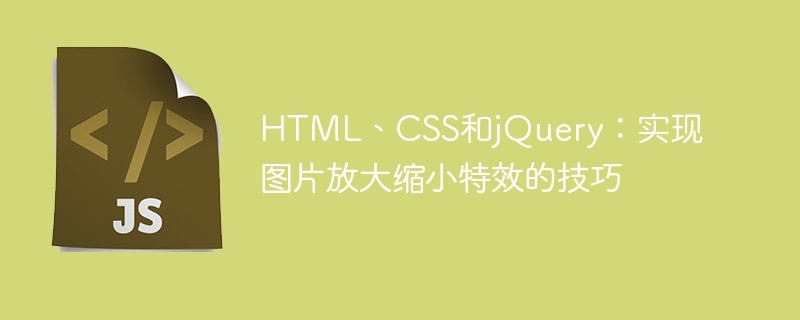

HTML, CSS and jQuery: Techniques for achieving image zoom-in and zoom-out special effects require specific code examples
With the development of the Internet, the design of web pages pays more and more attention to users experience. Among them, pictures, as one of the important elements of web design, can often bring users an intuitive and rich visual experience. The special effect of zooming in and out of images can enhance users' perception and interaction with web content, so it is widely used in web design. This article will introduce how to use HTML, CSS and jQuery to achieve special effects of zooming in and out of images, and provide some specific code examples.
1. HTML markup
First of all, the position and size of the image need to be specified in HTML. The following is an example HTML code:
<div class="image-container"> <img src="image.jpg" alt="图片" class="image" /> </div>
In the above code, image-container is the class name of the container where the image is placed, and image is the class of the image element name. Make sure to place the image files (e.g. image.jpg) in the same directory.
2. CSS Styles
Next, use CSS styles to specify the necessary styles for images and containers, and to set special effects for images. The following is an example CSS code:
.image-container {
position: relative;
width: 400px; /* 容器的宽度 */
height: 300px; /* 容器的高度 */
overflow: hidden;
}
.image {
position: absolute;
top: 0;
left: 0;
width: 100%; /* 图片的初始宽度 */
height: 100%; /* 图片的初始高度 */
transition: all 0.3s; /* 设置过渡效果 */
}
.image:hover {
transform: scale(1.1); /* 鼠标悬停时放大的比例 */
}In the above code, image-container specifies the width and height of the image container, and sets overflow: hidden , causing the image to be partially hidden outside the container. image specifies the position and transition of the image, and uses the transform: scale attribute to achieve the magnification effect when the mouse is hovering.
3. jQuery script
Finally, introduce the jQuery library into HTML and use the methods it provides to achieve further interaction with images. The following is an example jQuery code:
<script src="https://code.jquery.com/jquery-3.6.0.min.js"></script>
<script>
$(document).ready(function() {
$(".image").click(function() {
$(this).toggleClass("zoomed"); /* 切换图片的放大状态 */
});
});
</script>In the above code, first ensure that the script is executed after the document is loaded through the $(document).ready() method. Next, select all images with the image class through the $(".image") selector and bind the click event. When clicking on the image, the toggleClass method will switch the class name between zoomed and image, thereby achieving the effect of clicking to zoom in and out.
Through the above code examples of HTML, CSS and jQuery, you can achieve special effects of zooming in and out of images. You can adjust the size of the container and pictures according to your own needs, as well as the specific style of the special effects. At the same time, you can also combine other interactive effects to add more animation effects, gradient effects, and other visual effects to the zoom-in and zoom-out effects of the image to enhance the user experience.
Summary:
Using HTML, CSS and jQuery, you can easily achieve special effects of zooming in and out of images. Through reasonable HTML tags and CSS styles, combined with simple binding and operation of jQuery scripts, you can add richer interactive effects to web design. In actual applications, the code can be adjusted and expanded according to your own needs to meet more design requirements.
The above is the detailed content of HTML, CSS and jQuery: Techniques for achieving special effects of zooming in and out of images. For more information, please follow other related articles on the PHP Chinese website!
 How to modify the text in the picture
How to modify the text in the picture
 What to do if the embedded image is not displayed completely
What to do if the embedded image is not displayed completely
 How to make ppt pictures appear one by one
How to make ppt pictures appear one by one
 How to make a round picture in ppt
How to make a round picture in ppt
 What is digital currency trading
What is digital currency trading
 Usage of calendar class in java
Usage of calendar class in java
 How to solve the problem that the hard disk partition cannot be opened
How to solve the problem that the hard disk partition cannot be opened
 python comment shortcut keys
python comment shortcut keys




